than any other country in the world*
Stop ISRAELI WAR CRIMES and GENOCIDE

|
ISRAEL MURDERED MORE CHILDREN
than any other country in the world* Stop ISRAELI WAR CRIMES and GENOCIDE Your Seeds Source...
| ||
| ||
This area offers relatively untouched low altitude (300 - 500 m. above sea level) vegetation on sides of a very good unpaved road.
This area can be reached either from Temuco, taking first the road to Cunco (about 60 km.) and then towards Colico Lake (15 km, first 9 km. paved), altogether about 1 hour. The other option is to drive from Pucon/Curarrehue through Reigolil, a somewhat solitary road which does not present any problems. From Pucon to Curarrehue there are about 40 km (paved) and it takes about half an hour, and the second stretch may take up to an hour and 30 km (to Reigolil). The road from Reigolil is very scenic, and you will also climb to a pass at about 1000 m, so that you would be able to see higher altitude vegetation from the car.
There is only one route which follows the main road; all the botanical sights are within a few meters from the road, and it is virtually impossible to hike off the road because the forests are very dense. There are four major areas, Colico Lake shore, Caburga Lake shore, quite similar to Colico, but less touched by human intervention and offering several species which are not found elsewhere; additionally, it has an area which is flooded in winter with corresponding vegetation, mid-altitude vegetation and finally Araucaria and timberline vegetation.
This section is relatively civilized, with lots of private property which restricts somewhat the access to the plants. It is a little bit difficult to pinpoint the exact locations where to see the plants, because the vegetation is quite similar along the whole stretch of the lake (almost 20 km.). Be prepared to see here and there Eucryphia cordifolia and Laurelia sempervirens. The former is a beautiful, huge towering tree with prolific white flowers in February. Embothrium coccineum which is almost a plague here covers the shores with fiery red flowers in November-December. Fuchsia magellanica, probably the most common shrub here, continues with the red theme in January-February. Among the smaller notable species one should mention Francoa appendiculata, a very ornamental plant, very easy to grow and undemanding. There are several species of ferns, with Blechnum chilense being the dominant species along the road.

Just at the beginning, when the road from Cunco reaches the shores of Colico, about 200 meters from the Marina (first access to the lake), watch for the relatively rare Satureja multiflora on the left side of the road. At the same spot you can also find the first Caldcluvia paniculata plants.
With a bit of luck, half way along the shore (10 km.), you can spot an occasional Weinmannia trichosperma tree which can be identified by the reddish color of its small fruits in February and March.
After passing the lake, there is a stretch of road which runs across fields and planted forests, and which is not especially interesting in botanical terms. Only when you begin to approach the Caburga Lake the native vegetation returns in its full force. After crossing several times the Trafampulli River, the road comes to a camping (Playa Negra) and the first glimpse of the Caburga Lake. From here on the areas becomes extremely interesting.

Just a few hundred meters past the camping on your right you will see a small, but dense forest of Drimys winteri, easily recognizable from distance by its distinctively whitish foliage. This species is very common in Southern Chile and is an indicator of humid, usually swampy areas, so that it is not a very good idea to try and roam around there. The road enters then a stretch of Nothofagus obliqua forest and then begins its final descend to the Caburga Lake. On the left (up-slope) side of the road you will see enormous leaves of the Lophosoria quadripinnata fern, and then Coriaria ruscifolia. The latter is a very interesting plant; it is said to have been used by peasants as a pest control to kill mice and rats, because its seeds are very poisonous. However, the fleshy petals which enclose the seeds contain sweet and supposedly edible juice... But tasting it would obviously be a poker game. The plant has beautiful leaves though and is a very ornamental. Also in the same area, on the right side of the road there are brushes of Leptocarpha rivularis, easily distinguishable by its yellow flowers and by a strong scent of the seeds; recently, a study appeared suggesting that it may have an effect on cancer.
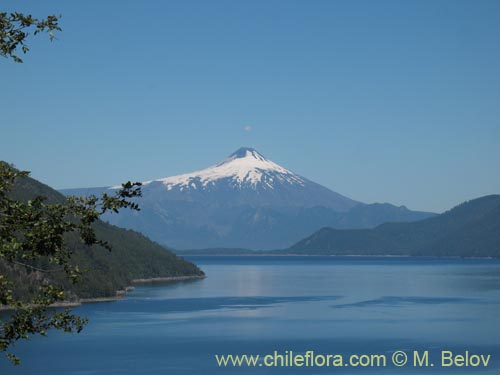
The road finally reaches the lake shore, and there is a track to the right going across a plain. The tracks reach a shallow river which one can wade through (even by a two-wheel drive car); if you do not dare to cross, you might just turn left to return to the main road. In that area before crossing the river you can see Myrceugenia exsucca, a plant which grows near or in water (remember, this area is inundated in winter) covered on the underside of the branches and southern parts of trunks by Sarmienta repens, beautiful climbers with fleshy heart-shaped leaves and red flowers which grow on the tree trunks of Myrceugenia exsucca. If you decide to cross, you will see more of the Myrceugenia exsucca plants and also Berberis. This is an excellent place for staying overnight if you have the gear for it. And it is also a heaven for the water birds, so if you want to combine flora watching with bird watching, this is the place.
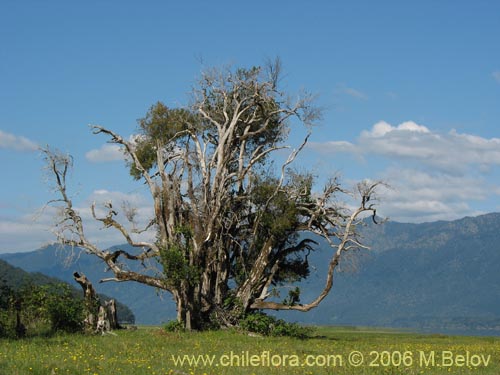
When returning, cross back the river and instead of turning left back the way you came in continue straight for about 100 m. This will take you back to the main road. Just a few meters before reaching the main road (there is a short climb there), check out the Lapageria rosea on the left as well as Boquila trifoliolata vines. After you exit to the main road, turn right and at about 50 m. you may be lucky to see Tropaeolum speciosum, with its showy bright red flowers. This species is quite a rare plant difficult to find.
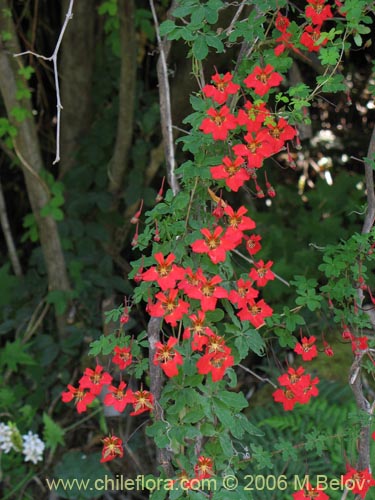
Take your time to check out the vegetation along the roadside in this area. The combination of the lake, which reduces the temperature fluctuations, the exposure towards the South, and the high cliffs which reduce the direct sunlight to a minimum create a very special microclimate here which sustains a varied and interesting flora. You certainly will notice the Mitraria coccinea with red flowers very similar to the Sarmienta repens, Loasa acerifolia, Calceolaria dentata ssp. araucana, Francoa appendiculata, Galium hypocarpium. With a bit of luck and looking carefully into the wood on the up-hill side of the road you may spot Luzuriaga radicans growing on the tree trunks. This plant has red fruits and belongs to the same family as Lapageria rosea. Cissus striata plants do not have showy flowers, but their dark fruits are easy to spot.
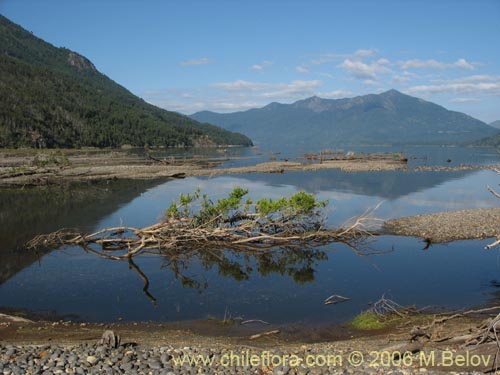
A little further (1 km.), after crossing a small wooden bridge the road will begin to climb again and the vegetation changes. The extremely wet conditions aided by the lake and steep cliff which protects the lake shore from direct sunlight become somewhat drier, giving way to a different type of vegetation. On the roadsides you can see small Ugni molinae plants, Gevuina avellana; both of these species are edible. There are also Caldcluvia paniculata, Persea lingue, and the Rhaphithamnus spinosus. The latter has beautiful bluish fruits. There is another Loasa, Loasa acanthifolia, very similar to the Loasa acerifolia which grows just two kilometers back the road.
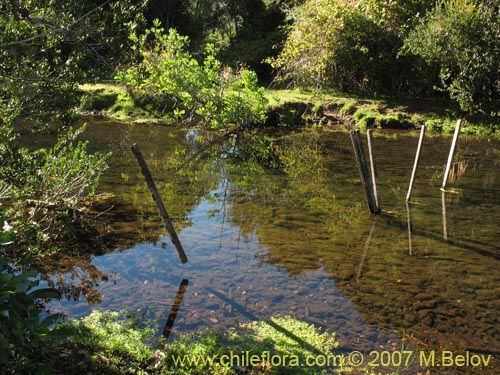
If you continue, the road begins to climb and reaches a cross road; if you turn right, you can visit Termas de Río Blanco, and if you continue straight, you can go to Reigolil.
Although these springs are not especially attractive, the area around them offers an interesting vegetation, with two key species: Saxegothaea conspicua and Desfontainia spinosa, well worth a visit. Both of these plants can be seen on the sides of the road. From Termas there is also a hiking route into the Huerquehue Park (a long walk which requires gear for overnight stay).
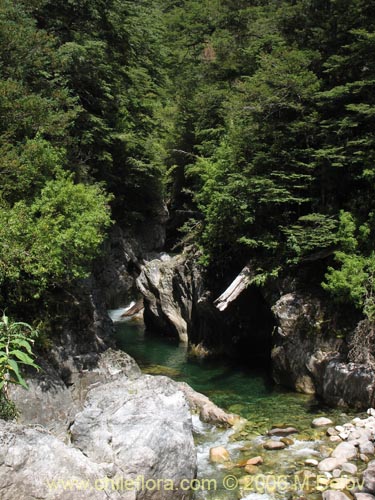
Continuing up the main road which climbs steeply in zig-zag you will see predominant Nothofagus dombeyi trees with a lot of Chusquea quila; the vegetation here is not as varied as below, but quite distinct, because it is considerably higher. Among the more interesting species you can see there Berberis darwinii and Drimys andina, strictly high mountain plant. There is a section where burnt rests of huge Nothofagus dombeyi trees can be seen, a man-made disaster. Finally, the road will make the final climb to reach a pass (this area is already in the Villarica National Reserve), in the vicinity of which Alstroemeria aurea and Ovidia andina can be seen, all of which is dominated by the impressive Araucaria araucana trees.
If you choose to continue, the road will descend to more populated areas where local Indians live. This part of the trip is recommendable only if you want to go to Pucon/Villarica, since the vegetation here is not especially interesting. The only species worth mentioning is Dasyphyllum diacanthoides. It is a rather big tree belonging to the asteraceae family.
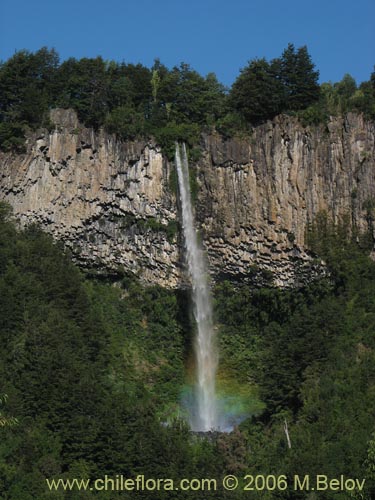
Calceolaria dentata ssp. araucana
Myrceugenia ovata var. nannophylla